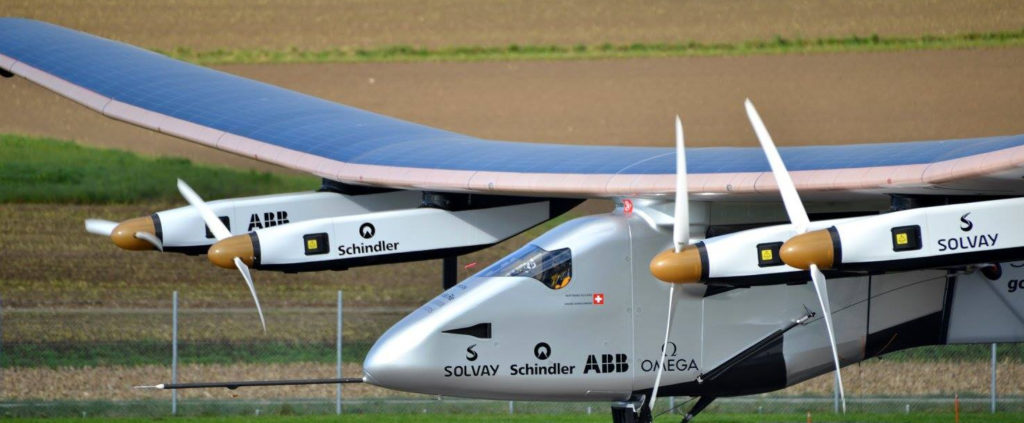The recent adventures of Solar Impulse II almost completing a round-the-world flight (1st of August 2016 update: Congratulations to the Solar Impulse team, they have completed their circumnavigation!) have shown that solar-powered aircraft are undeniably possible. In an ever-changing world where aviation is under increasing pressure on both cost and environmental grounds to reduce fuel consumption, is it just a matter of time then until we see a completely solar-powered passenger aircraft? Let’s have a look at the numbers.

CC BY-SA 4.0 Milko Vuille 2014
Can we put Solar Panels on Everything?
Aircraft use a huge amount of energy to fly, and the energy is stored very densely as kerosene in the fuel tanks. Could harnessing the sun’s power ever be a replacement?

The graph above compares the total power used in flight per unit wing area for various aircraft. If commercial airliners had similar values to the power provided by the sun, it would be feasible to create solar powered airliners by installing solar panels on the wings. The sad truth is that the sun provides a much smaller amount of energy than needed; the Solar Impulse only manages to fly at all by having a wingspan bigger than most airliners, yet carrying a single pilot and flying at just 90 km/h (55 mph). Fitting solar panels similar to those on the Solar Impulse II to the entire wing area of a Jumbo Jet would provide less than 2% of the cruise power at optimal conditions. So fitting current generation airliners with solar panels doesn’t make sense.
Will It Ever Be Possible?
I think solar powered aircraft have a bright future in drone aircraft, hybrid electric aircraft and some military applications but a solar powered airliner seems a step too far. The power per unit wing area of an airliner would need to be reduced to a 50th of its current value at the very minimum. Even combining optimistic future advances in solar panel technology, materials, aerodynamics, systems and applying them all to a slow flying aircraft with a massive wing, the required improvements fall an order of magnitude short.
It is in fact clear that a passenger airliner will never be a solely solar powered aircraft. The sun simply does not provide enough energy to power such a large and fast aircraft directly, without even beginning to take into account the difficulties of night and high latitude flight.
References
Below is a table showing the data and calculations for the graph above.
| Aircraft | Power | Wing Area | Power/Area | Comparison to Sun | References |
| Solar Impulse II | 52.2kW* (70hp) | 269.5m2 (2901ft2) | 0.19kW/m2 | 14.3% | The Solar Impulse Website (29.7.2016) (Engine Power) (Wing Area) *The Solar Impulse collects more power than this, since it can charge it batteries and drive its engines at the same time. |
| Cessna 172 | 119kW (160hp) | 16.2m2 (174ft2) | 7.36kW/m2 | 545% | Janes‘s All the World‘s Aircraft 2002-2003 Edition. |
| ATR-72 (Take-Off) | 3220kW (4320hp) | 54.5m2 (587ft2) | 59.1kW/m2 | 43732% | Janes‘s All the World‘s Aircraft 2002-2003 Edition. |
| Boeing 747-400 (Cruise) | 49824kW (66814hp) | 525m2 (5651ft2) | 94.9kW/m2 | 70246% | Wing Area: Janes‘s All the World‘s Aircraft 2002-2003 Edition. Engine Power: Introduction to Aircraft Design, John P. Fielding, 1999 (Rolls-Royce RB211-524G data). |
| Midday Sun | 1.35kW (1.8hp) | 1m2 (10.76ft2) | 1.35kW/m2 | 100% | ASTM E490 Standard Solar Constant and Zero Air Mass Solar Spectral Irradiance Tables (2014) |
Edit: This article was update on the 1st of August 2016. The data for the 747 at take-off was removed since there was no reference data for it, a reference table for the other values was added and the graph was changed from log scale to normal scale for emphasis.